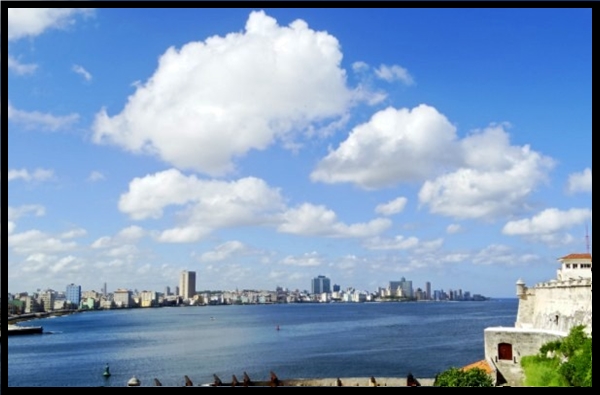
Havana skyline from El Moro Fort
10 Free Things to do in Havana – Cuba
Many visitors to Cuba are surprised at how expensive it can become. Havana, in particular, has many famous attractions, restaurants, bars, tours and activities with entry fees and/or prices that can quickly add up to a lot of money.
But it’s also quite easy to visit Cuba on a tight budget for those who prepare in advance. In addition to staying at inexpensive guest houses and eating at cheap local restaurants, anther great way to keep costs low is to take advantage of Havana’s many wonderful free attractions and activities.
Here are 10 fantastic free things to do in Havana. They’re not only worth doing because they’re free, but because they are actually some of the best things to do in the city!
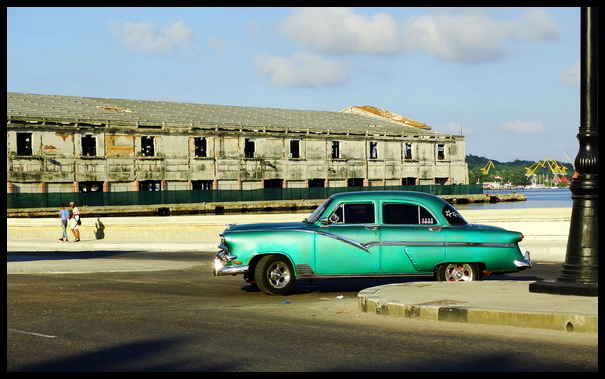
vintage green car driving on Havana’s malecon near the ferry piers & warehouses
1. Admire Cuba’s gorgeous vintage cars
Cuba’s beautiful, colorful vintage cars are one of the the country’s very best attractions. Nowhere else on the planet can you see thousands of 1950s cars, in every color of the rainbow and in tip-top condition, driving freely around the roads. Although they’re found all over the island, the highest concentration are in Havana.
There are several ideal places around the city to marvel at the beauties. I recommend the following:
1. The malecon (seaside road) as it runs along the eastern side of Havana Vieja – specifically between Hotel Santander on south end to Fort Castillo de San Salvador de la Punta in the north. A non-ending parade of vintage cars run along this road in both directions, many carrying tourists in open convertibles.
2. In late afternoon/evenings, many cars gather in front of Hotel Santander, across from the ferry terminal.
3. Vintage cars also concentrate at all times of day & night at Central Park in front of the stunning Gran Teatro building, as well as on the north and east sides of the park. Cars are always running past the neighboring Capitolio building in both directions.
4. Vintage cars also run continuously through Park de la Fraternidad, situated on the south side of Capitolio. .
5. Another great area is across the canal, east of Havana Vieja, in the region called Casa Blanca. Dozens of gorgeous cars parade tourists between El Cristo statue at the south end, Fortaleza del San Carlos de la Cabaña in the center and El Morro Fort at the north end.
All these spots are also great places to photograph the amazing historic cars.
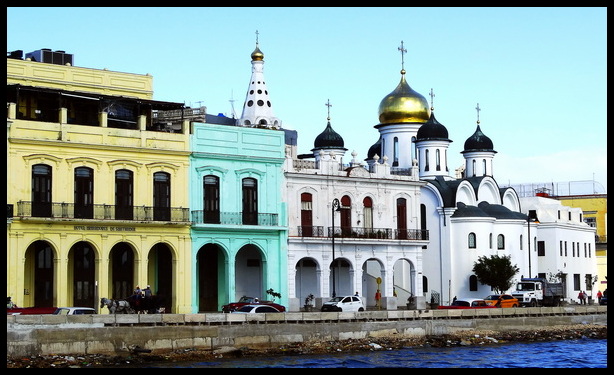
Havana malecon near ferry piers in Old Havana
2. Stroll the malecon
Walking along the malecon between the same points mentioned above is a real treat, completely aside from the stunning cars. In fact, I think it’s one of the very best walks in Havana.
Starting at the south end, you’ll pass several gorgeous iconic buildings and plazas, including Hotel Santander, the Orthodox Russian Cathedral with its gilded turrets, Havana Club Rum Museum, huge historic warehouses, Plaza de San Francisco, Fort Castillo de la Real Fuerza and then two large parks, finally ending at Fort Castillo de San Salvador de la Punta. Several days per week you’ll also find a massive cruise ship towering over the canal on the north end of the warehouse buildings, across from Plaza de San Francisco.
While admiring stunning buildings, plazas and parks on the city side of the malecon, you’ll also be distracted by gorgeous views across the canal to Casablanca, most of it set on top of a tall bluff and cliffs.
El Cristo statue looms into the sky at the hill’s highest point. The massive, long stone walls of Fortaleza del San Carlos de la Cabaña occupies most of the high cliff region. At the northern point, neighboring El Morro Fort guards over the entrance to the canal.
And then there’s the vast dark Atlantic Ocean expanding out to the horizon in every direction at the north end. From Fort Castillo de San Salvador de la Punta there are sweeping views westward along the continuing malecon and Havana’s long skyline stretching over to historic Hotel Nacional in the Vendado neighborhood in western Havana.
The malecon itself looks particularly grand along the parks, just south of Fort Castillo de San Salvador de la Punta, where the road is split and lined by elegant palm trees, and where vibrant vintage convertibles, in pristine condition, and proud horse-drawn-carriages promenade along in both directions.
All in all, it’s probably Havana’s most dramatic and beautiful area.
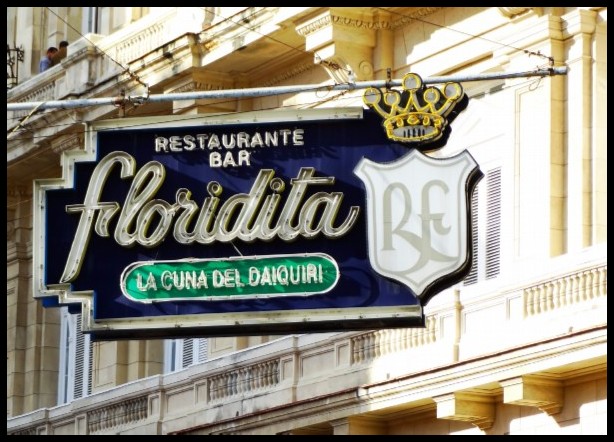
La Floridita – Havana – famous hang out of Hemmingway
3. Join Havana’s daily FREE city walking tours
Every morning at 9:30, a free 3-hour Old Havana walking tour meets in the northern area of Old Havana at the corner of Calle Compestela and Calle Cuarteles, in front of Cafe de Angel. The spot is situated just one short block east of the Museum of the Revolution.
The tour is also, rather amazingly, marked on Google Maps as ‘Free Walking Tour Havana’ even though there’s no office or shop. Everyone meets outside, separates into groups based on language spoken, then heads out on the very informative tours. They even have this website!
When I joined the walking tour, lead by a young Cuban university student, I learned a lot about Cuban history, daily life and Cuban perspectives as well as intriguing histories of many of Havana’s most iconic buildings and neighborhoods.
This free tour is really a fantastic way to begin a visit to Havana, before setting out to see the sites on your own.
Apparently in high season they require participants to pre-register, which you can do on their website or by calling for a reservation.
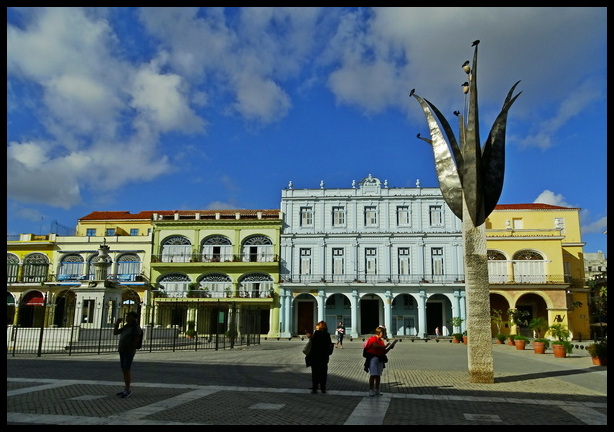
Plaza Vieja – Havana
4. Visit Old Havana’s four major historic plazas
Havana Vieja is noted for its four major plazas: Plaza Vieja, Plaza San Francisco, Plaza de Armas and Plaza de la Cathedral. Each is quite distinctive and surrounded by gorgeous historic buildings. Plaza de Armas is a leafy, shady park, while the others are open stone plazas.
All are free, of course, and worth visiting. They are great places to watch people: tourists, Cuban artists, street performers and locals just hanging out with friends.
Plaza Vieja, in particular, has a lot to see & do for anyone who takes time to really visit every building surrounding the plaza. You could easily spend a half day exploring.
There are several art galleries, the free Museum de Naipes (decks of cards!), a cafe/coffee roaster, a beer brewery, several restaurants with outdoor seating and miscellaneous shops. Street performers, featuring circus characters walking on tall stilts accompanied by live Cuban music, stroll through the plaza. Live Cuban bands play in evenings. And the streets leading out from the plaza, in all directions, have more galleries, small museums, cafes and restaurants.
Plaza de Armas is the best plaza for sitting under cool, shady trees and watching locals hang out. Plaza de la Cathedral and Plaza San Francisco have more historic buildings, roving artists and art galleries to browse.
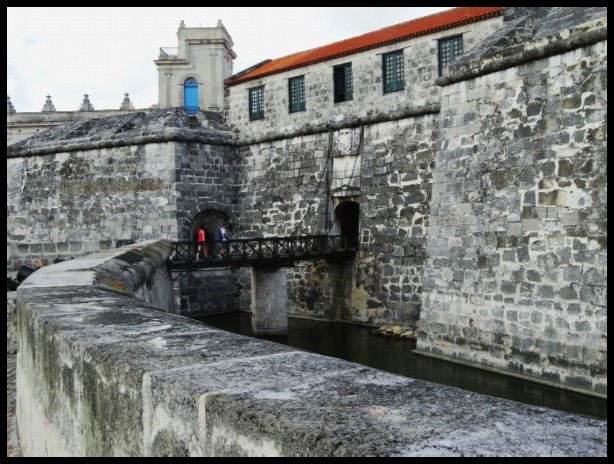
Fort Castillo de la Real Fuerza – Havana
5. Visit free museums, historic houses and forts
Havana has more than 300 museums, showcasing everything from art to history, stamps, military, culture, the revolution, photography and many other specialty topics. The most famous & important museums have entry fees of $3-8 CUC. While those prices are reasonable, the costs quickly add up if you visit many.
Luckily, dozens of Havana’s lesser-known, but very interesting, museums, historic houses and even the less popular forts are free. While I was in the city, I visited all of the following for free:
Museum of Pharmacy, Museum of Naipes, Casa Africa, Casa Asia, Casa del Arabe, Casa Alejandro Humborldt, Casa Oswaldo Guzman, Palacio del Conde Lombillo and Fort Castillo de San Salvador de La Punta.
All of these are situated in Old Havana and you can find all of them marked on Google maps.
I also attempted to visit several other free museums I knew about, but many had been closed for a year or longer.
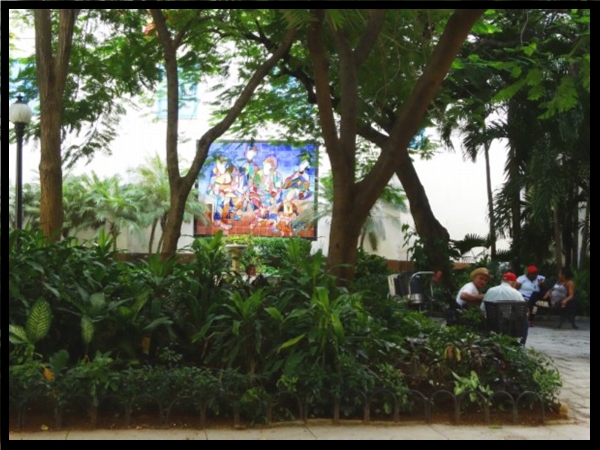
Art in park – Havana
6. Hang out in Havana’s many parks
In addition to these interesting plazas, Havana is dotted with small shady parks that are generally not mentioned in tourist information. I discovered most of them accidentally while wandering around the city.
Park Central is an exception. It’s a famous & popular park near Capitolio building, situated in front of Gran Teatro and several historic hotels. It offers many shady trees, stone benches and great views of vintage cars. But it tends to be full of tourists and you’re likely to be pestered by vintage car drivers and other touts.
In contrast, Havana’s tiny, little-known parks are much quieter and pest-free. Here are a few nice ones in Havana Vieja I particularly recommend :
Park de la Fraternidad, situated ont eh south side of Capitolio building, is a rather large, shady park where many locals hang out, but nary a traveler. It’s an excellent place to sit on benches and watch a never-ending stream of gorgeous vintage cars pass by as well as observing the daily habits of local residents.
Park Humbolt, just one block southeast of Plaza Vieja, is filled with shady trees and park benches. It’s also full of cats and dogs. Across the street is a small souvenir shop/art gallery that doubles as an animal shelter for Havana’s many stray cats & dogs (more on that below) who often hang out in the park. This is obviously a great park for cat and dog lovers.
Park Cervantes is located between Calles Empedrado, Habana, San Juan de Dios and Aquilar. It’s an open, grassy park where locals congregate, but not tourists.
Park Guayasamin on Mercaderes Street, two blocks north of Plaza Vieja, has a beautiful tiled mural, gorgeous trees and a bit of landscaping. Sometimes local musicians and singers hang out there.
Havana is full of many other similar parks where you can escape tourist crowds, take a break and watch daily life go by.
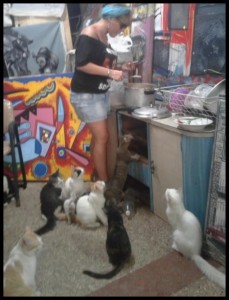
cats waiting to eat in one of Havana’s animal rescue center at Park Humboldt
7. Pet street cats & dogs at the animal shelter
As I just mentioned, there’s an animal shelter inside a small souvenir shop/art gallery, situated on the side of Park Humboldt. The owners resue the city’s many stray dogs & cats, with an objective to find them each a new home.
Every day the shop staff cook up a big pot of rice, chicken scraps and whatever else they have on hand, to feed dozens of animals living there, awaiting a home. They also have a vet come in to administer anti-flea cream and give sick animals medicines.
While I was in Havana, I visited nearly every day to pet the animals and sometimes help with feeding. Most of the time, the shop had over 20 cats and several dogs & puppies. The dogs found homes quickly, but the cats seemed to stay longer.
The cost of taking care of the animals comes purely from donations and some proceeds of sales. So if you really want to help out, and can afford it, even a few dollars helps out trememdously. Meanwhile, petting and playing with the animals is free!
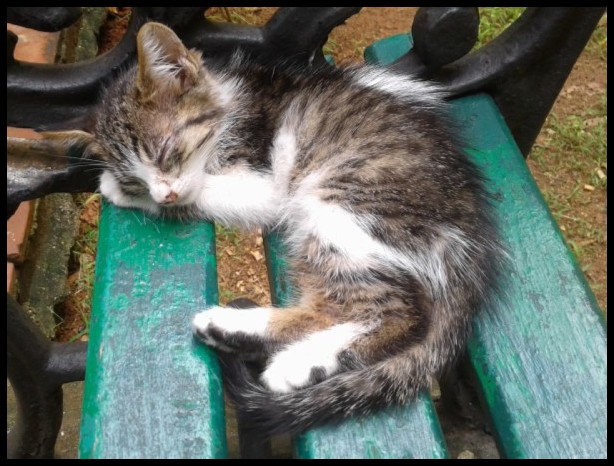
the adorable kitten I rescued in Havana
8. Rescue a stray cat or dog
This same animal shelter takes in any strays brought to them by locals or tourists, alike. During my time in Havana, I took two kittens there on separate occassions. The first kitten found a home within three days! The second one I delivered just two days before I left Cuba, so I don’t know how long he was there, but he did find new kitten friends right away!
So while you’re wandering around Havana, if you come across any stray dogs or cats that seem to need help or a home, take them over to the animal shelter.
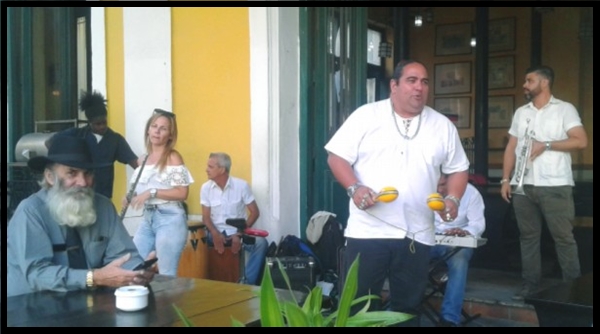
Cuban band in Plaza Vieja – Havana
9. Watch street performers and musicians
Traditional Cuban music bands play outdoors at various restaurants, cafes and bars throughout Old Havana. They usually start up in mid afternoon or evenings.
You’ll find them at Plaza Vieja and Plaza de la Catedral in evenings, on Calle Obispo near famous Hotel Ambos Mundo, and other locations. You’re bound to hear at least one band while you’re wandering around. Feel free to stop and listen, even if you’re not eating or drinking at the place featuring the musicians.
At Plaza Vieja, just about every day, some very interesting street performers, featuring circus characters walking on tall stilts accompanied by live Cuban music, pass through the plaza then walk up and down nearby streets, creating a festive atmosphere wherever they go. They collect donations from people as they pass by, but everyone is certainly welcome to watch the lively procession whether they donate or not.
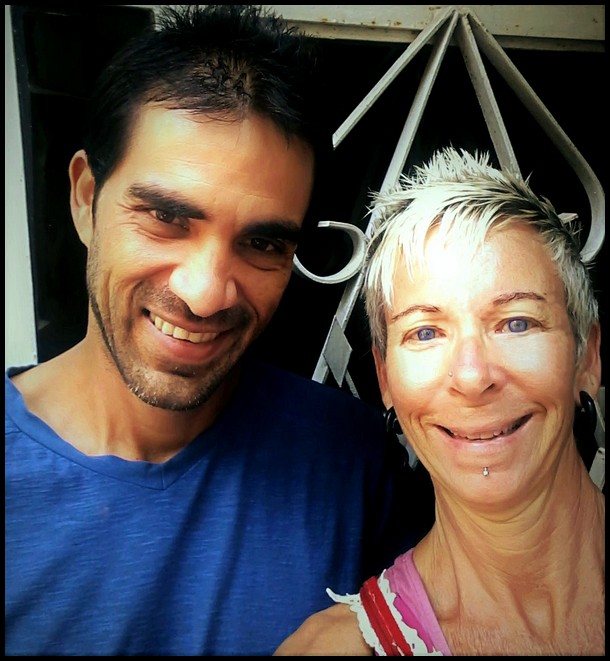
Carlos of Hostal Mango in Havana
10. Chat with locals about life in Cuba
Talk with your guest house hosts, chat with street artists, talk to museum & shop staff, hang out with locals in the parks. Ask them questions about your observations, about their perspectives on Cuba and daily life. You’ll learn a lot about Havana, Cuba, its history and people.
It’s fun. People appreciate your curiosity and interest. And you’ll leave Cuba with a much richer, more accurate picture of the country than you would otherwise.
Although many Cubans do not speak English well, if at all, most locals involved in the tourist industry do. Guest house owners, taxi drivers, restaurant & bar staff at popular venues, tour guides and others generally speak English quite well. If you can speak Spanish, even better! But if not, you can still learn a lot speaking to people in English.
You might find the following articles useful:
Costs of Budget Travel in Cuba – 2018
28 Money-Saving Tips for Travel in Cuba
Preparing to Visit Cuba for Americans
==============================









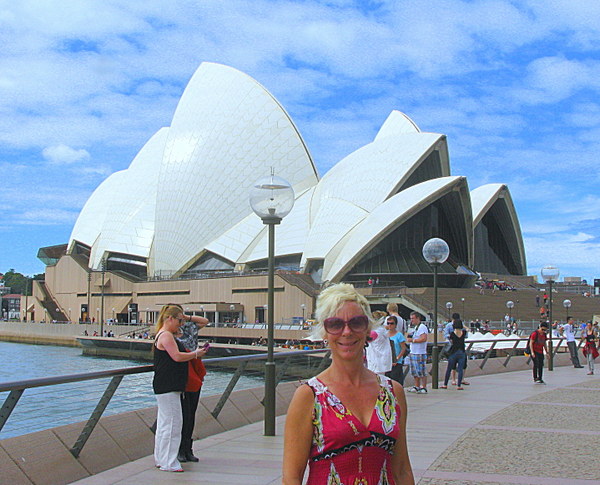
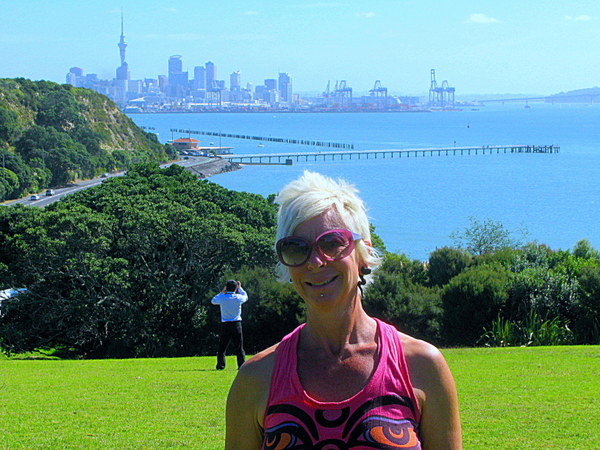

 Hi! I'm Lash, an American nomadic world traveler who's been traveling solo since 1998. I’m passionate about traveling the world nomadically and then sharing it all with you. I hope to inspire you to travel the world, to entertain you with tales from the road, and to help you reach your travel dreams. Welcome!
Hi! I'm Lash, an American nomadic world traveler who's been traveling solo since 1998. I’m passionate about traveling the world nomadically and then sharing it all with you. I hope to inspire you to travel the world, to entertain you with tales from the road, and to help you reach your travel dreams. Welcome! 




2 pings